Pipeline Inspection Tests Using a Biomimetic Robot
Abstract
:1. Introduction
2. Methodology
| Robot | Use | Characteristics | Design Requirements | Pipe Size |
|---|---|---|---|---|
| Three-limb spider-like robot [9] | Inspection of planar tunnel environments. | Algorithm for selecting the footholds of a three-limb robot. The algorithm assumes knowledge of the tunnel geometry. | No mention of component replacement. It does not avoid obstruction. | 90–100 cm |
| The ROBOTURK SA-2 Robot [11] | Applications in industry, defence, and natural disasters. | Design and control of an eight-legged with a single actuator. | Avoid obstacles but not in pipe. No mention of component replacement | - |
| The MRINSPECT IV robot [13] | Gas pipe inspection. | Design to straight pipelines, elbows, and branches and different diameter pipes. | Only translational movement It does not avoid obstruction. No mention of component replacement. | 8.5–10.9 cm |
| The Pirate robot [14] | Inspection of low-pressure gas distribution networks. | Using omnidirectional wheels that allow direct control of the orientation in the pipe. | Control automatic of movement translational and rotational It does not avoid obstruction. | 6.3–12.5 cm |
| New in-pipe inspection robot [17] | Inspection petrochemistry, water supply, and liquid transport pipes | It uses wheels in a vertical and horizontal position. Horizontally or vertically pipe, straight pipelines and elbows. | It does not avoid obstruction. Movement and rotational only one module | 12.7–15.2 cm |
| Inspection Robot CAD [18] | Inspection gas pipelines, water pipelines and drain pipes | Pipe horizontally or vertically, straight pipelines and elbows. 2 motors for 8-wheel movement. Use springs to adapt to different diameter. | Only for translational movements It does not avoid obstruction. | 14–20 cm |
| Robot “MORITZ” [24] | Inspection gas pipelines | Climb through pipes of different inclinations. Can manage tube junctions. | Not mention if avoid obstacles. Only for translational movements. | 60–70 cm |
| Micro Inspection Robot [25] | Inspection for 1-in Pipes in the chemical industry | A dual hand for manipulating small objects in pipes. Developed several microdevices and micromechanisms. | It does not have movement rotational. It does not avoid obstacles. | 2.54 cm |
| Abigaille II spider-like robot [28] | Flat vertical surfaces inspection. | Able to climb vertical surfaces and surfaces of any inclination. | Avoid obstacles but not in the pipe. Only movement translational. | - |
| Robot with camera compensation [29] | Inspection water supply pipeline | Passive adaptation ability. A different algorithm is tested to compensate the camera image rotation. | Control automatic of movement rotational. No mention of component replacement. | 12–18 cm |
| Robot hybrid, leg and wheels [30] | Inspection plastic or metallic pipes | Operate inside pipes of different diameters. | It does not avoid obstacles. Only movement translational. | 12.5–18 cm |
| Kinematic modelling robot [31] | Inspection gas pipelines | Having three caterpillar wheel chains. Pipeline with elbows. | It does not avoid obstruction. | 10–12 cm |
2.1. Robot Movement Control
2.2. Numerical Analysis
2.3. Pipeline Inspection Tests
3. Results
4. Conclusions
Author Contributions
Funding
Institutional Review Board Statement
Informed Consent Statement
Data Availability Statement
Acknowledgments
Conflicts of Interest
References
- Ceccarelli, M.; Kececi, E.F. Designs and Prototypes of Mobile Robots; ASME Press: New York, NY, USA, 2015. [Google Scholar]
- Murphy, R.R. Marsupial and Shape-Shifting Robots for Urban Search and Rescue. IEEE Intell. Syst. Appl. 2000, 15, 14–19. Available online: https://ieeexplore.ieee.org/document/850822 (accessed on 9 March 2021).
- Li, P.; Ma, S.; Li, B.; Wang, Y. Development of an adaptive mobile robot for in-pipe inspection task. In Proceedings of the 2007 International Conference on Mechatronics and Automation, Harbin, China, 5–8 August 2007; IEEE: New York, NY, USA, 2007; pp. 3622–3627. [Google Scholar]
- Zhang, H.; Zhang, J.; Liu, R.; Zong, G. Realisation of a service robot for Cleaning spherical surfaces. Int. J. Adv. Robot. Syst. 2005, 2, 53–58. [Google Scholar] [CrossRef] [Green Version]
- Karlsson, N.; Munich, M.E.; Goncalves, L.; Ostrowski, J.; di Bernardo, E.; Pirjanian, P. Core Technologies for Service Robotics. In Proceedings of the International Conference on Intelligent Robots and Systems, Sendai, Japan, 28 September–2 October 2004; IEEE: New York, NY, USA, 2004; Volume 3, pp. 2979–2984. [Google Scholar]
- Cecarelli, M.; Carbone, G. Design and Operation of Human Locomotion Systems; Elsevier: London, UK, 2020. [Google Scholar]
- Vidoni, R.; Gasparetto, A. Efficient force distribution and leg posture for a bio-inspired spider robot. Robot. Auton. Syst. 2011, 59, 142–150. [Google Scholar] [CrossRef]
- Kitano, S.; Hirose, S.; Endo, G.; Fukushima, E.F. Development of lightweight sprawling-type quadruped robot TITAN-XIII and its dynamic walking. In Proceedings of the IEEE International Workshop on Intelligent Robots and Systems, Tokyo, Japan, 3–7 November 2013; IEEE: New York, NY, USA, 2013; pp. 6025–6030. [Google Scholar]
- Sapiro, A.; Rimon, S.S.E. A foothold selection algorithm for spider robot locomotion in planar tunnel environments. Int. J. Robot. Res. 2005, 24, 823–844. [Google Scholar] [CrossRef]
- Yi, W.Z.; Tong, W.J.; Hong, J.A.; Kai, L.H.; Dong, D.Z. Movement behavior of a spider on a horizontal surface. Chin. Sci. Bull. 2011, 56, 2748–2757. [Google Scholar]
- Soyguder, S.; Alli, H. Motion mechanism concept and morphology of a single actuator tetrapod walking spider robot. Ind. Robot. 2011, 38, 361–371. [Google Scholar] [CrossRef]
- Roslin, N.S.; Anuar, A.; Jalal, M.F.A.; Sahari, K.S.M. A review: Hybrid locomotion of in-pipe inspection robot. Procedia Eng. 2012, 41, 1456–1462. [Google Scholar] [CrossRef] [Green Version]
- Roh, S.G.; Choi, H. Strategy for navigation inside pipelines with differential drive in pipe robot. In Proceedings of the 2002 IEEE International Conference on Robotics and Automation (Cat. No.02CH37292), Washington, DC, USA, 11–15 May 2002; IEEE: New York, NY, USA, 2002; Volume 3, pp. 2575–2580. [Google Scholar]
- Dertien, E.; Foumashi, M.M.; Pulles, K.; Stramigioli, S. Design of a robot for in-pipe inspection using omnidirectional wheels and active stabilization. In Proceedings of the 2014 IEEE International Conference on Robotics and Automation (ICRA), Hong Kong, China, 31 May–7 June 2014; IEEE: New York, NY, USA, 2014; pp. 5121–5126. [Google Scholar]
- Vorotnikov, S.A.; Nikitin, N.I.; Ceccarelli, M. A Robotic System for Inspection and Repair of Small Diameter Pipelines. Sci. Educ. Bauman MSTU 2015, 2, 180–196. [Google Scholar] [CrossRef] [Green Version]
- Ceccarelli, M.; Carbone, G.; Bastianini, E.; Rivieccio, A.; Alfieri, S. Design constraints and features for a robotic system cutting pipelines in nuclear vessels. In Proceedings of the RAAD 2014 23rd International Conference on Robotics in Alpe-Adria-Danube Region, Smolenice, Slovakia, 3–5 September 2014; IEEE: Smolenice, Slovakia, 2014; Volume 3, pp. 121–126. [Google Scholar]
- Nayak, A.; Pradhan, S.K. Design of a new in-pipe inspection robot. Procedia Eng. 2014, 97, 2081–2091. [Google Scholar] [CrossRef] [Green Version]
- Gargade, A.; Tambuskar, D.; Thokal, G. Modelling and analysis of pipes inspection Robot. Int. J. Emerg. Technol. Adv. Eng. 2013, 3, 120–126. [Google Scholar]
- Huang, H.P.; Yan, J.L.; Cheng, T.H. Development and fuzzy control of a pipe inspection robot. IEEE Trans. Ind. Electron. 2010, 57, 1088–1095. [Google Scholar] [CrossRef]
- Choi, H.R.; Ryew, S.M. Robotic system with active steering capability for internal inspection of urban gas pipelines. Mechatronics 2002, 12, 713–736. [Google Scholar] [CrossRef]
- Muramatsu, M.; Namiki, N.; Koyama, R. Autonomous mobile robot in pipe for piping operations. In Proceedings of the 2000 IEEE/RSJ International Conference on Intelligent Robots and Systems (IROS 2000) (Cat. No.00CH37113), Takamatsu, Japan, 31 October–5 November 2000; IEEE: New York, NY, USA, 2000; pp. 2166–2171. [Google Scholar]
- Horodinca, M.; Dorftei, I.; Mignon, E.; Preumont, A. A simple architecture for in-pipe inspection robots. Int. Colloq. Mob. Auton. Syst. 2002, 61–64. [Google Scholar]
- Gálvez, J.A.; Santos, P.G.; Pfeiffer, F. Intrinsic tactile sensing for the optimization of force distribution in a pipe crawling robot. IEEE/ASME Trans. Mechatron. 2001, 6, 26–35. [Google Scholar] [CrossRef]
- Zagler, A.; Pfeiffer, F. “MORITZ” a pipe crawler for tube junctions. In Proceedings of the IEEE International Conference on Robotics and Automation, Taipei, Taiwan, 14–19 September 2003; IEEE: New York, NY, USA, 2003; pp. 2954–2960. [Google Scholar]
- Suzumori, K.; Miyagawa, T.; Kimura, M.; Hasegawa, Y. Micro inspection robot for 1-in pipes. IEEE/ASME Trans. Mechatron. 1999, 4, 286–292. [Google Scholar] [CrossRef]
- McAllister, E. Pipeline Rules of Thumb Handbook; Gulf Professional Publishing: Oxford, UK, 2013. [Google Scholar]
- Esparza, G.R.; Cummings, R.M.; Hung, C.P. Guide of Procedures and Techniques for Road Maintenance in Mexico; General Directorate of Technical Services: Mexico City, Mexico, 2014. (In Spanish) [Google Scholar]
- Menon, C.; Li, Y.; Sameoto, D.; Martens, C. Abigaille-I: Towards the development of a spider-inspired climbing robot for space use. In Proceedings of the 2008 2nd IEEE RAS & EMBS International Conference on Biomedical Robotics and Biomechatronics, Scottsdale, AZ, USA, 19–22 October 2008; IEEE: New York, NY, USA, 2008; pp. 384–389. [Google Scholar]
- Yuan, Z.; Yuan, J. Design and implementation of a pipeline inspection robot with camera image compensation. In Proceedings of the 2020 IEEE/RSJ International Conference on Intelligent Robots and Systems, Las Vegas, NV, USA, 25–29 October 2020. [Google Scholar]
- Lim, H.; Ohki, T. Development of pipe inspection robot. In Proceedings of the 2009 ICCAS-SICE, Fukuoka, Japan, 18–21 August 2009; IEEE: New York, NY, USA, 2009; pp. 5717–5721. [Google Scholar]
- Kwon, Y.; Yi, B. The kinematic modeling and optimal paramerization of an omni-directional pipeline robot. In Proceedings of the 2009 IEEE International Conference on Robotics and Automation, Kobe, Japan, 12–17 May 2009; IEEE: New York, NY, USA, 2009; pp. 1389–1394. [Google Scholar]
- Carbone, G.; Malchikov, A.; Ceccarelli, M.; Jatsun, S. Design and Simulation of Kursk Robot for in-Pipe Inspection. In The 10th IFToMM International Symposium on Science of Mechanisms and Machines SYROM’09; Springer: Dordrecht, The Netherlands; Brasov, Romania, 2009; pp. 103–114. [Google Scholar]
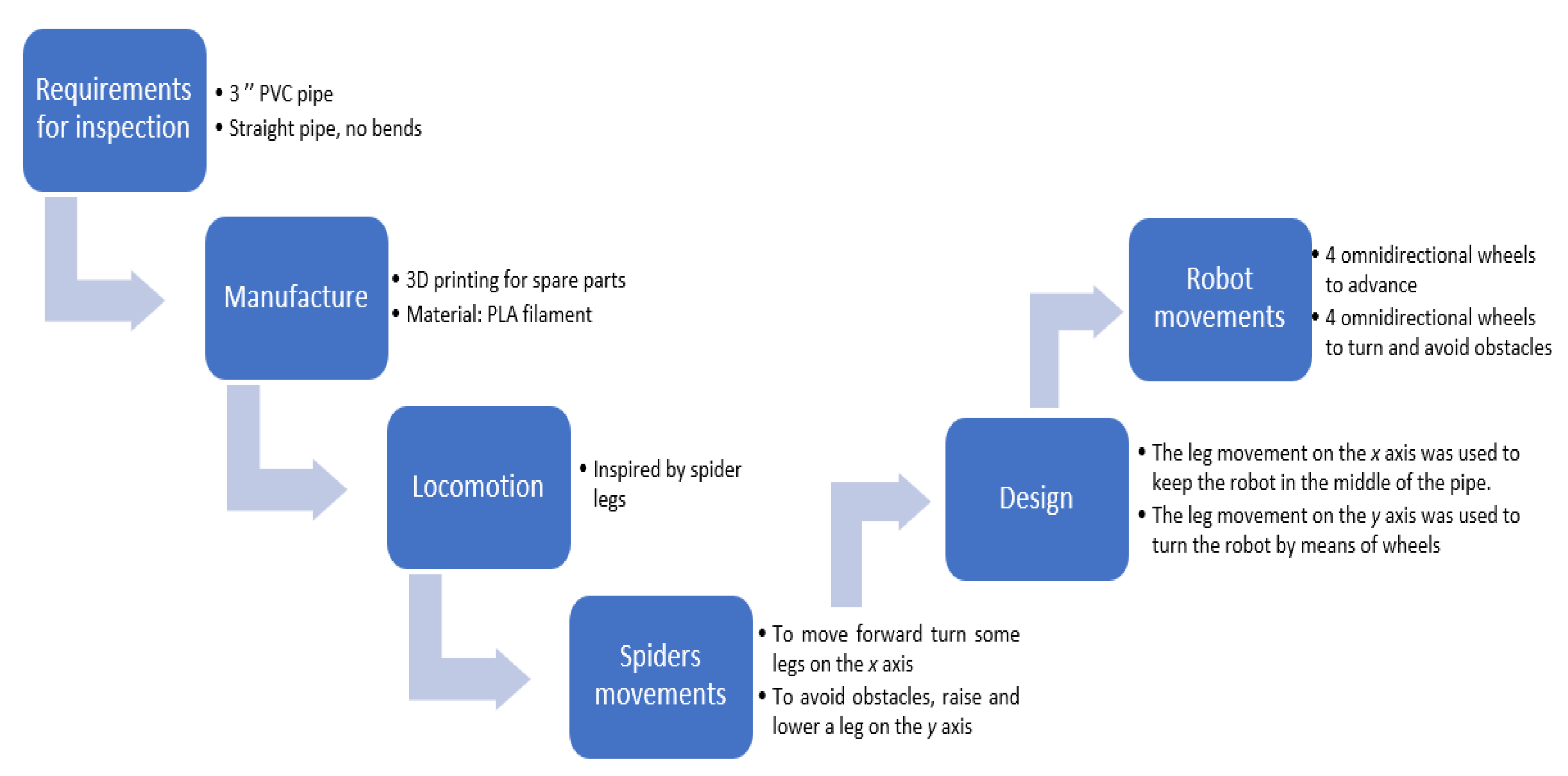






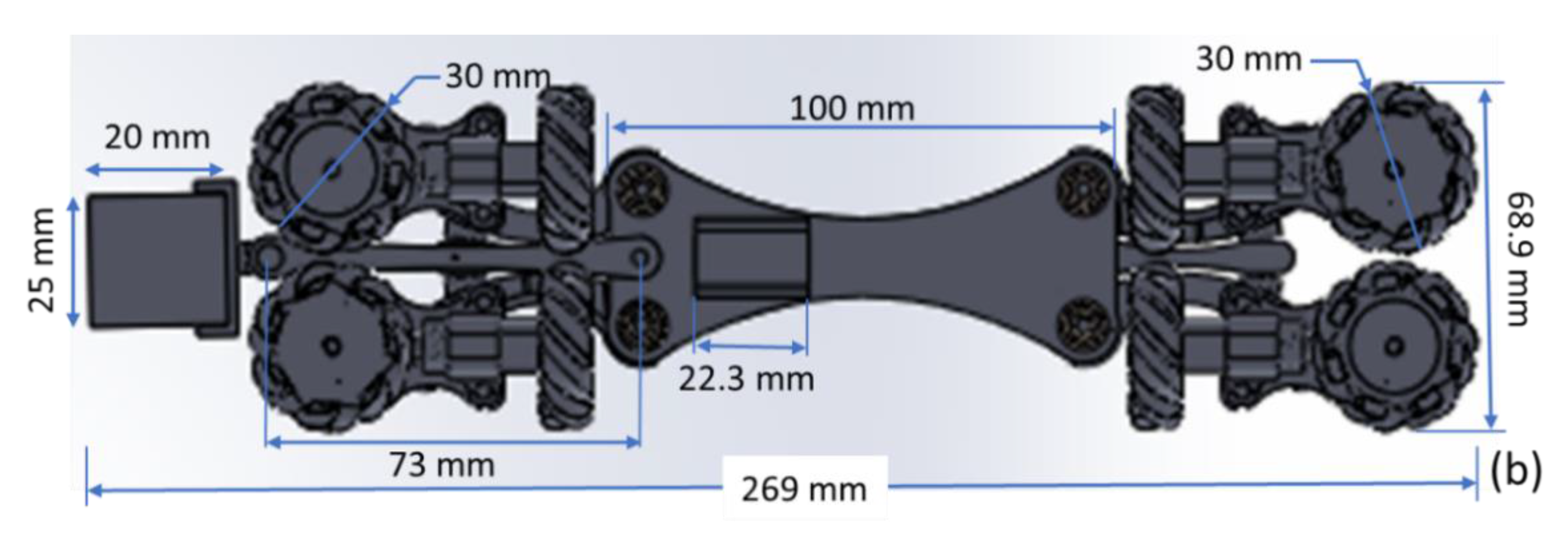
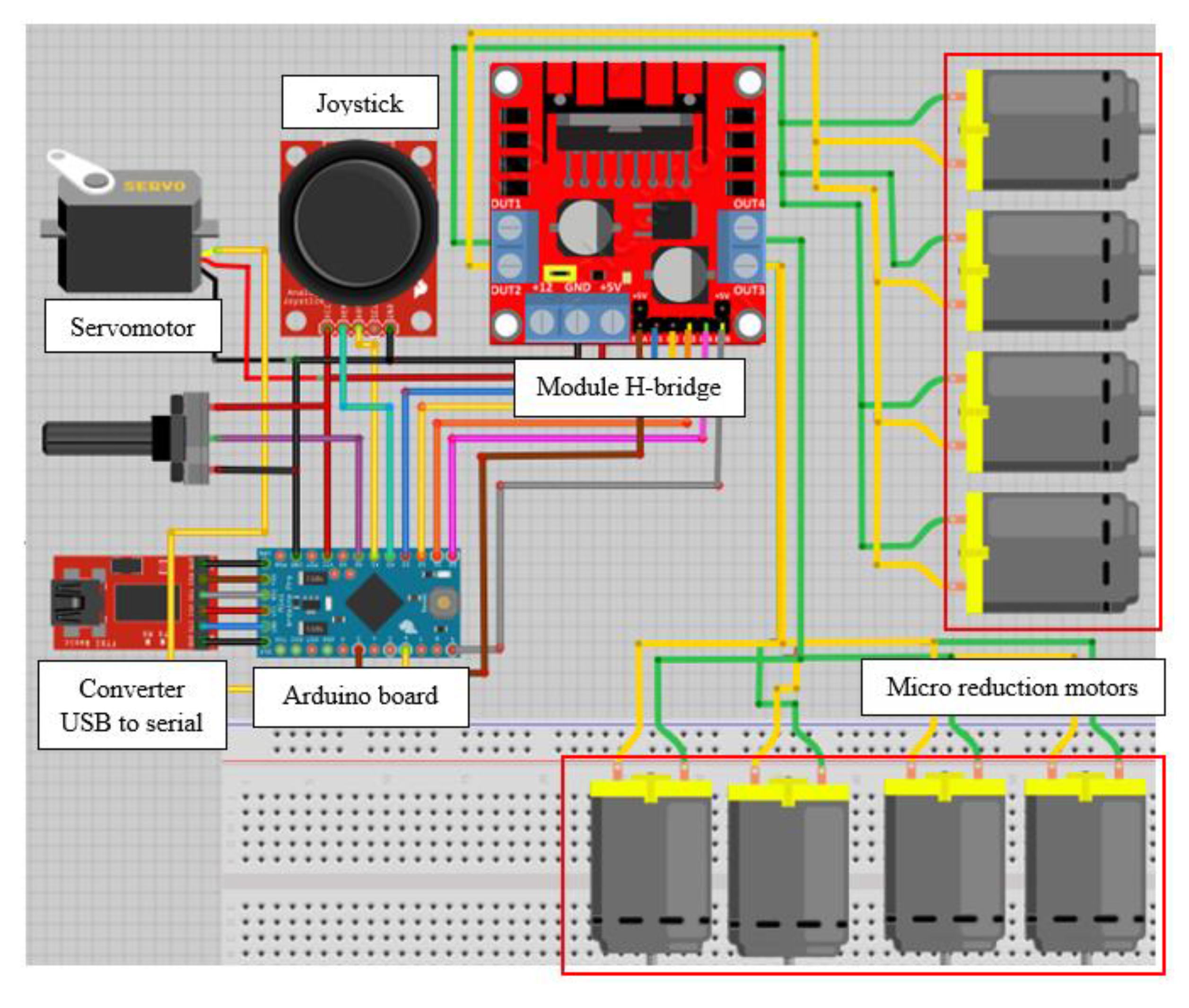

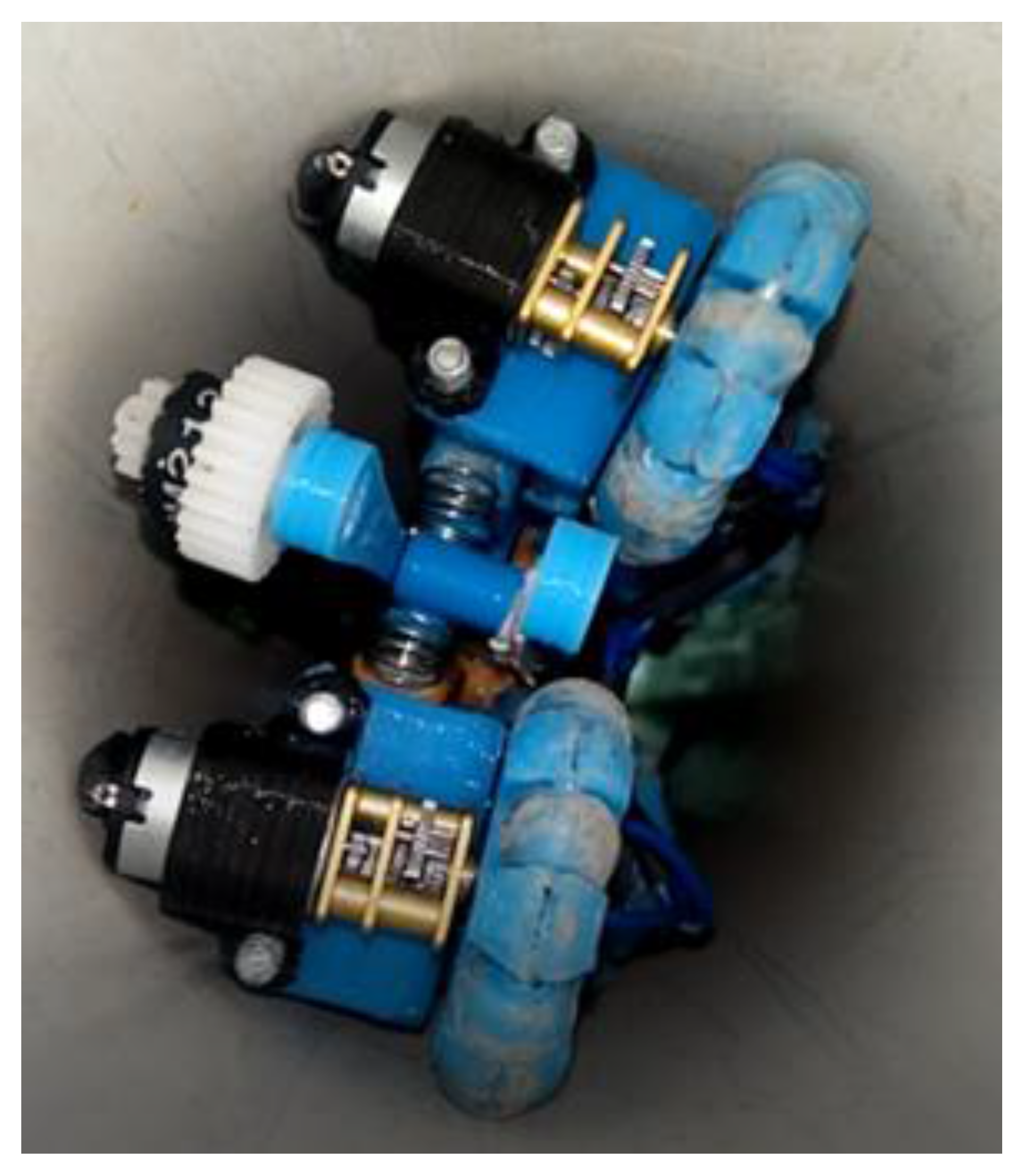
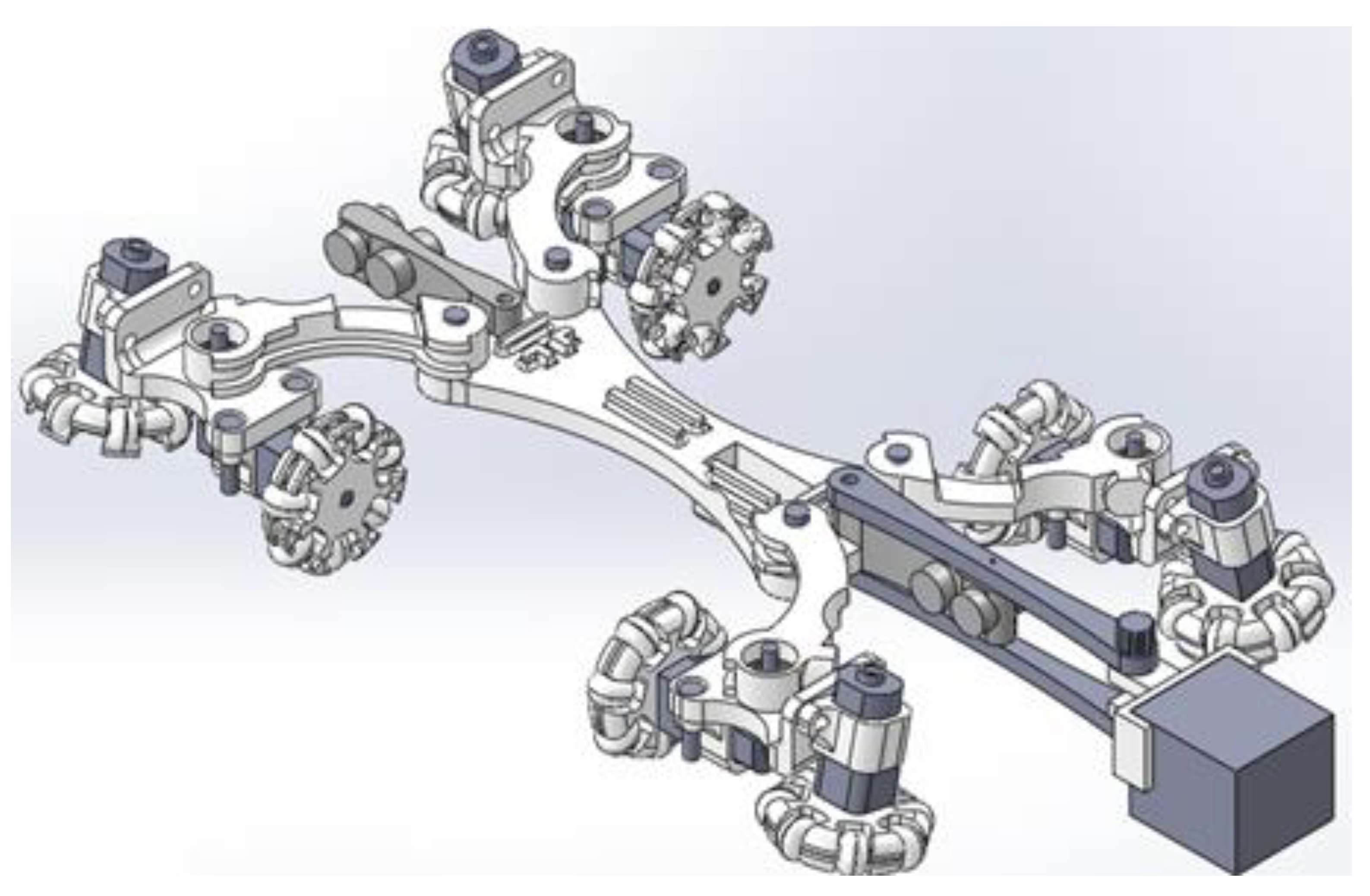

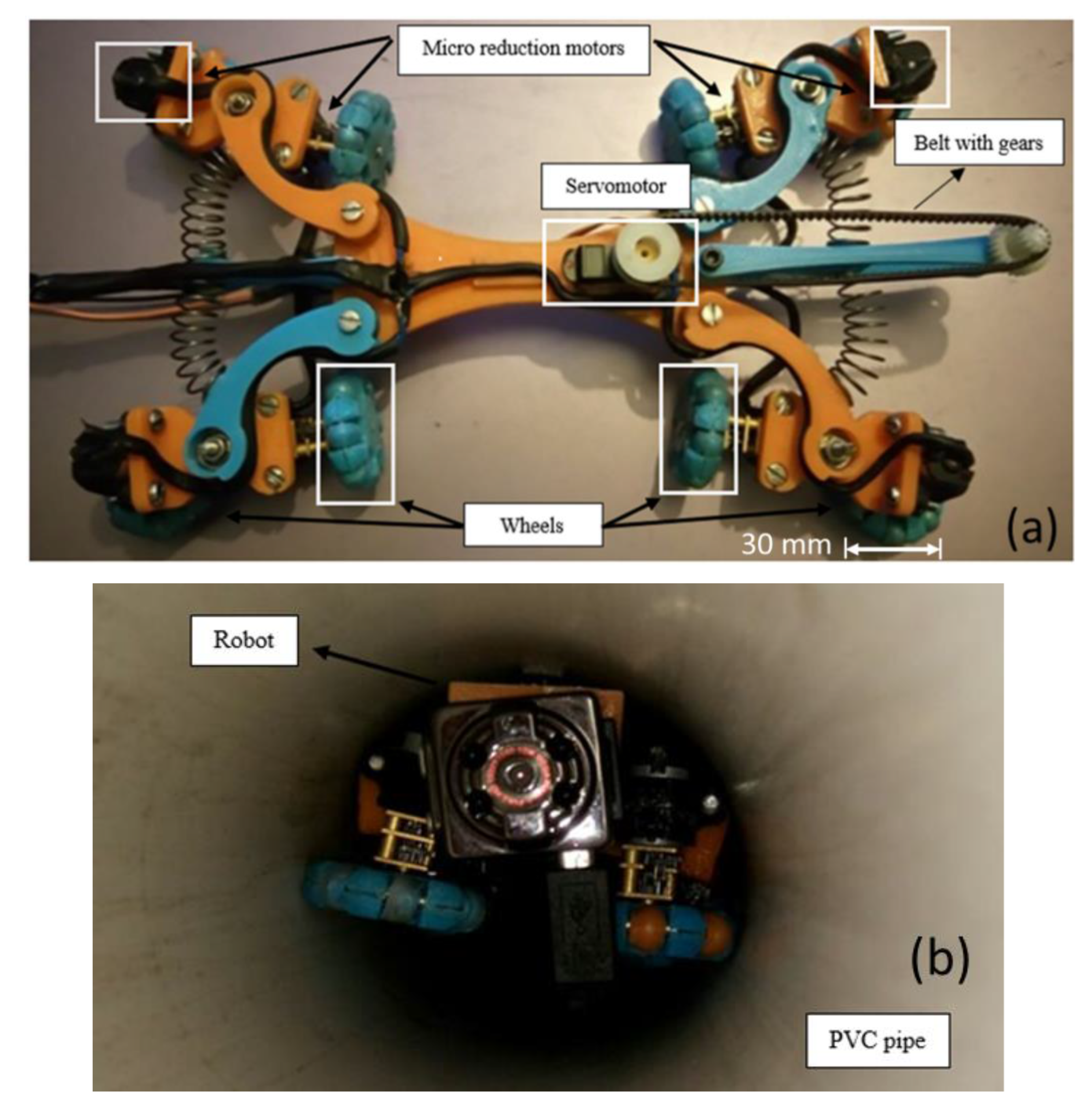
| Components | Characteristics |
|---|---|
| Arduino® card |
|
| Joystick |
|
| Module H-bridge |
|
| Converter USB to serial |
|
| Micro Metal Gearmotor LP 6V |
|
| Servomotor |
|
Publisher’s Note: MDPI stays neutral with regard to jurisdictional claims in published maps and institutional affiliations. |
© 2021 by the authors. Licensee MDPI, Basel, Switzerland. This article is an open access article distributed under the terms and conditions of the Creative Commons Attribution (CC BY) license (http://creativecommons.org/licenses/by/4.0/).
Share and Cite
Islas-García, E.; Ceccarelli, M.; Tapia-Herrera, R.; Torres-SanMiguel, C.R. Pipeline Inspection Tests Using a Biomimetic Robot. Biomimetics 2021, 6, 17. https://doi.org/10.3390/biomimetics6010017
Islas-García E, Ceccarelli M, Tapia-Herrera R, Torres-SanMiguel CR. Pipeline Inspection Tests Using a Biomimetic Robot. Biomimetics. 2021; 6(1):17. https://doi.org/10.3390/biomimetics6010017
Chicago/Turabian StyleIslas-García, Elizabeth, Marco Ceccarelli, Ricardo Tapia-Herrera, and Christopher R. Torres-SanMiguel. 2021. "Pipeline Inspection Tests Using a Biomimetic Robot" Biomimetics 6, no. 1: 17. https://doi.org/10.3390/biomimetics6010017
APA StyleIslas-García, E., Ceccarelli, M., Tapia-Herrera, R., & Torres-SanMiguel, C. R. (2021). Pipeline Inspection Tests Using a Biomimetic Robot. Biomimetics, 6(1), 17. https://doi.org/10.3390/biomimetics6010017








